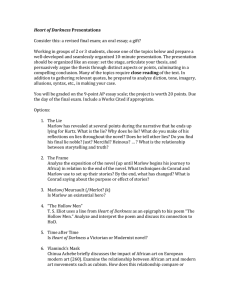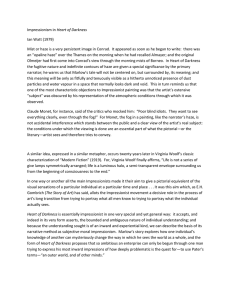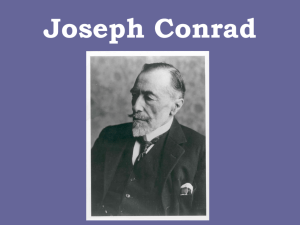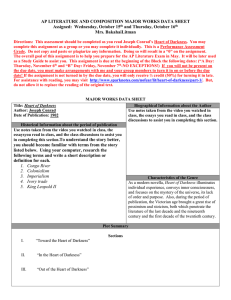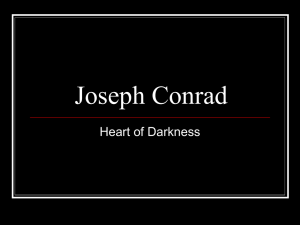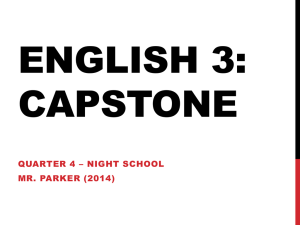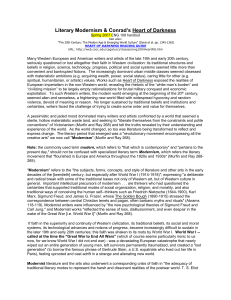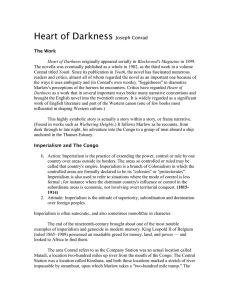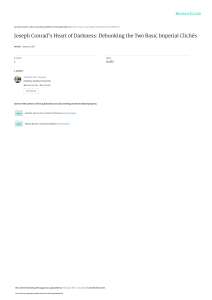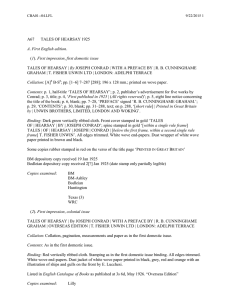November 30 * Heart of Darkness
advertisement
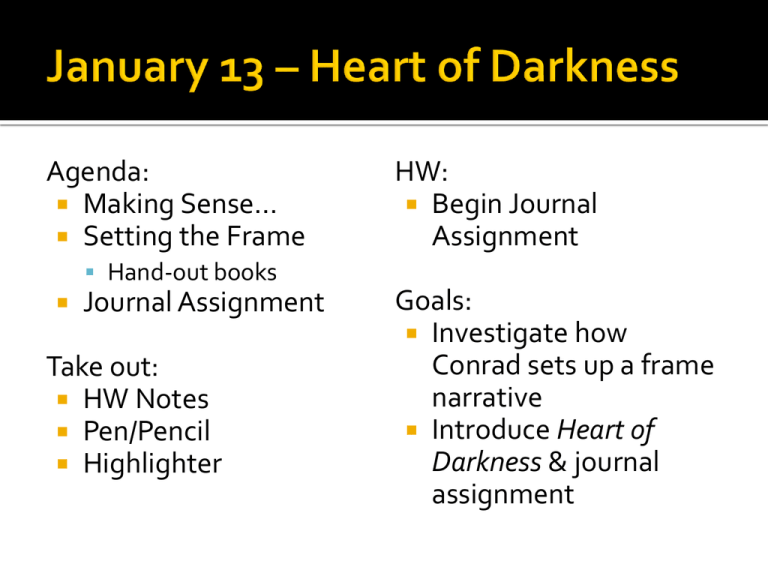
Agenda: Making Sense… Setting the Frame HW: Begin Journal Assignment Hand-out books Journal Assignment Take out: HW Notes Pen/Pencil Highlighter Goals: Investigate how Conrad sets up a frame narrative Introduce Heart of Darkness & journal assignment HoD is a FRAME NARRATIVE: A frame narrative or frame story: a story in which another story is enclosed or embedded as a ‘tale within the tale’, or which contains several such tales. Prominent examples of frame narratives enclosing several tales are Boccaccio's Decameron (1353) and Chaucer's Canterbury Tales (c. 1390), while some novels such as Mary Shelley's Frankenstein (1818) and Emily Brontë's Wuthering Heights (1847) employ a narrative structure in which the main action is relayed at second hand through an enclosing frame story. (Oxford Dictionary of Literary Terms) As you read Heart of Darkness, complete the following writing activities to help ensure that you read actively. Your final submission to me should be a numbered (like the list below), single-spaced, typed document submitted both in hardcopy and on turnitin.com following the completion of our reading of the novel. Follow each of the numbered directives below, completing each writing activity in full. When I ask that you “keep track of”, “pick”, “cite” or “find” anything, I expect you to record quotations and page numbers in your journal document. When I ask you to “discuss”, “explain” or “respond” to something, I expect you to do so in at least one well-written paragraph (unless otherwise noted). THIS IS A LOT OF WORK – DO NOT LEAVE IT UNTIL THE LAST MINUTE!!!!! 1. Keep track of any place that Marlow travels in the novella. Do this by noting the page number any time he mentions moving from one specific point to another. Discuss one specific, important detail concerning the place he goes and how long it takes to get there. 2. Find and discuss three references to work or keeping busy in Heart of Darkness, explaining Marlow’s position on the value of work. 3. Find three examples of the futility (uselessness, incongruity, stupidity) of the European presence in the Congo and discuss what Conrad is suggesting in each instance. 4. Find three passages (1-2 paragraphs each) from the novel that show Conrad’s impressionistic style. Provide a short analysis of each passage, focusing on those details that clearly reveal aspects of impressionistic writing. 5. Find four passages regarding women, explain what general attitudes about woman are being expressed in each, and how those attitudes fit into the novel as a whole. 6. Pick two of the following motifs (recurring images and/or ideas) and find at least four references to each. In this case, you may incorporate the four quotations, and then discuss how the idea works into the narrative of the novel as a whole in one or two paragraphs (not separate paragraphs for each quotation). The motifs you are to select from are: “savages”, jungle, disease, progress, madness, civilization, light, efficiency, bones/skulls/heads on stakes. 7. Respond to Kurtz’s final utterance. What is “the horror” to which he refers, and why are these words the final words he speaks? 8. Heart of Darkness is a frame story. An unnamed narrator begins the story on the deck of the Nellie in London on the Thames River. List every time there is a shift between this narrator and Marlow who narrates most of the story, and then discuss why Conrad would use the frame story structure for this novel. In what way does this structure contribute to or enhance the meaning of the work as a whole? 9. The three parts of this book are untitled. Create a title for each part, and explain why you chose that title.
